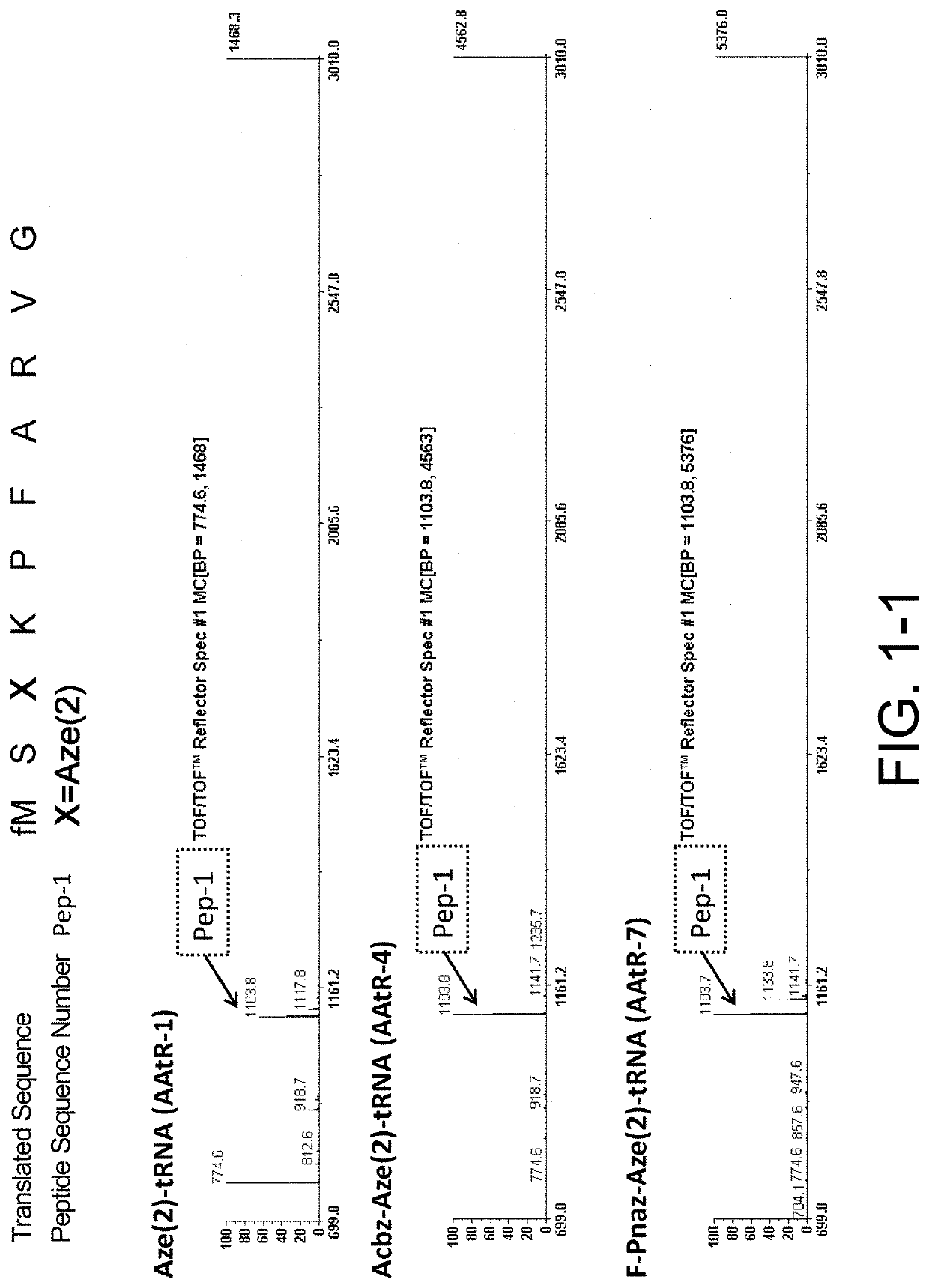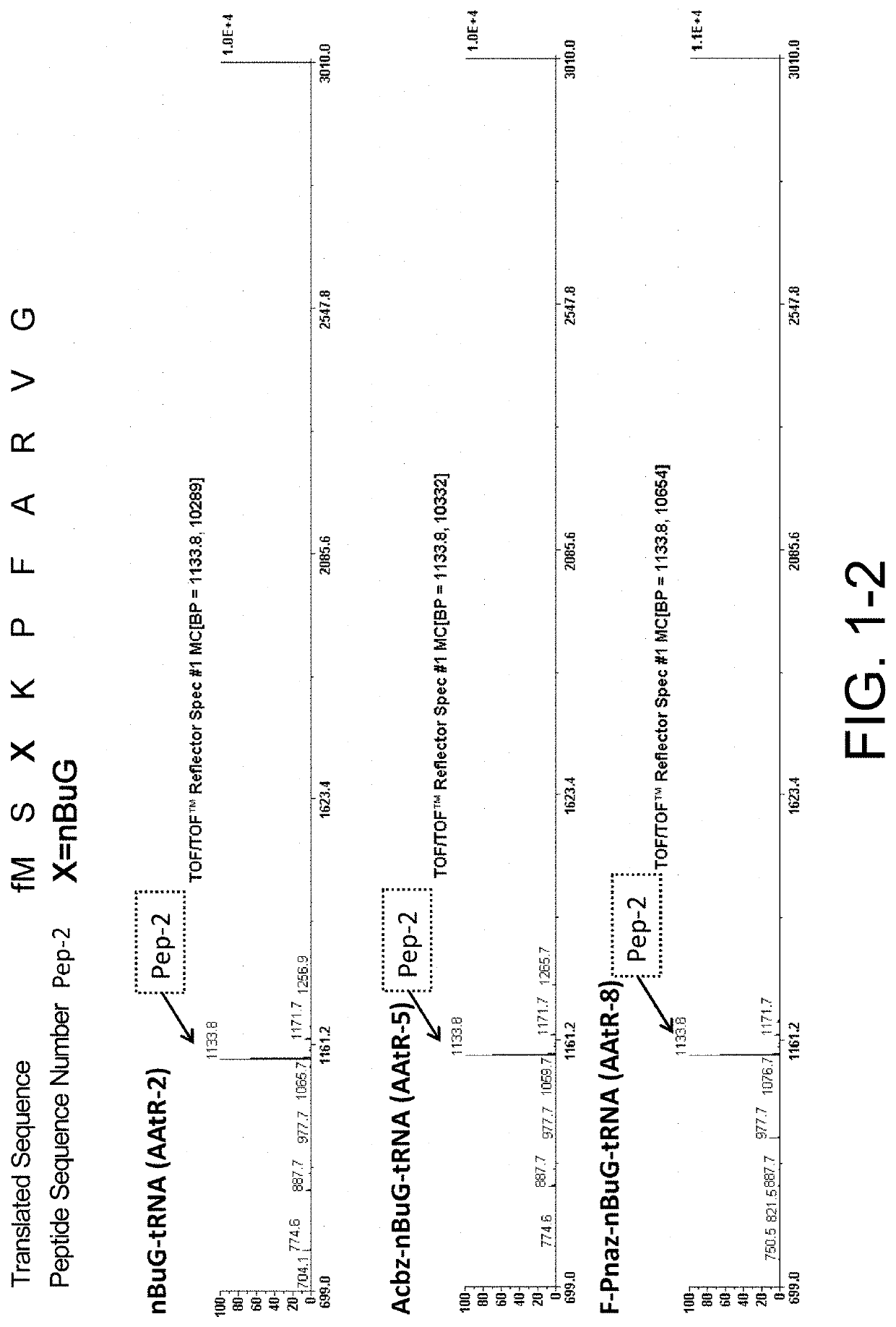Method for synthesizing peptides in cell-free translation system
a translation system and cell-free technology, applied in the field of cell-free translation system synthesizing peptides, can solve the problems of requiring a lot of time and effort, unable to achieve the effect of improving translation efficiency, and acylating the structure of amino acids which arss can acylate,
- Summary
- Abstract
- Description
- Claims
- Application Information
AI Technical Summary
Benefits of technology
Problems solved by technology
Method used
Image
Examples
example 1
Synthesis of pCpA-Amino Acids Used for Cell-Free Translation Systems
[0279]Aminoacylated pCpAs (ts05, ts07, ts09, ts14, ts19, ts20, ts23, ts26, ts29, TS03, TS06, TS09, TS12, TS15, TS18, TS21, TS24, TS29, TS34, and TS37) were synthesized according to the following scheme.
Synthesis of (5)-1-(((4-azidobenzyl)oxy)carbonyl)azetidine-2-carboxylic acid (Compound ts01, Acbz-Aze(2)-OH)
[0280]
[0281]Under a nitrogen atmosphere, DMSO (5.0 mL) was added at room temperature to a mixture of (S)-azetidine-2-carboxylic acid (H-Aze(2)-OH) (50.6 mg, 0.50 mmol), n-butylglycine (H-nBuG-OH) (65.6 mg, 0.50 mmol), (S)-2-((((4-azidobenzyl)oxy)carbonyl)amino)-3-(pyridin-3-yl)propanoic acid (83.0 mg, 0.50 mmol), and 4-azidobenzyl (4-nitrophenyl)carbonate (566 mg, 1.80 mmol) synthesized by the method described in the literature (Bioconjugate Chem. 2008, 19, 714). After stirring at room temperature for five minutes, triethylamine (418 μL, 3.00 mmol) was added at room temperature. The reaction mixture was stirred ...
example 2
Synthesis of Aminoacylated tRNA
[0540]The following tRNAGluUAG(-CA) was prepared by the ordinary method. Sequence Number TR-1 (SEQ ID NO: 1) tRNAGluUAG(-CA) RNA sequence:
GUCCCCUUCGUCUAGAGGCCCAGGACACCGCCCUUAGACGGCGGUAACAGGGGUUCGAAUCCCCUAGGGGACGC
[0541]The following tRNAGluACG(-CA) was prepared by the ordinary method. Sequence Number TR-2 (SEQ ID NO: 9) tRNAGluACG(-CA) RNA sequence:
GUCCCCUUCGUCUAGAGGCCCAGGACACCGCCCUACGACGGCGGUAACAGGGGUUCGAAUCCCCUAGGGGACGC
Synthesis of Aminoacylated-tRNA Using Aminoacylated pCpA: Part 1
[0542]10× Ligation buffer (500 mM HEPES-KOH pH 7.5, 200 mM MgCl2) (4 μL), 10 mM ATP (4 μL), and nuclease free water (5.6 μL) were added to 50 μM transcribed tRNAGluUAG(-CA) (Sequence Number TR-1) (20 μL), this was heated at 95° C. for two minutes and then left to stand at room temperature for five minutes to perform refolding of tRNA. 2.4 μL of 10 units / 4 T4 RNA ligase (New England Biolabs) and 4 μL of a 2.5 mM solution of aminoacylated pCpA (ts05, ts07, ts09, ts14, ts19, t...
example 3
Peptide Ribosomal Synthesis
[0546]Ribosomal synthesis was performed. The translation system used was PURE system, an E. coli-derived reconstituted cell-free protein synthesis system. Specifically, the synthesis was carried out as follows: 1 μM template mRNA and 250 μM each of amino acids, Ala, Phe, Gly, Lys, Met, Pro, Arg, Ser, and Val, were added to a cell-free translation solution (1% (v / v) RNasein Ribonuclease inhibitor (Promega, N2111), 1 mM GTP, 1 mM ATP, 20 mM creatine phosphate, 50 mM HEPES-KOH (pH 7.6), 100 mM potassium acetate, 6 mM magnesium acetate, 2 mM spermidine, 1 mM dithiothreitol, 1.5 mg / mL E. coli MRE600 (RNase-negative)-derived tRNA (Roche), 0.1 mM 10-HCO—H4 folate, 4 μg / ml creatine kinase, 3 μg / ml myokinase, 2 units / mL inorganic pyrophosphatase, 1.1 μg / mL nucleoside diphosphate kinase, 0.6 μM methionyl-tRNA transformylase, 0.26 μM EF-G, 0.24 μM RF2, 0.17 μM RF3, 0.5 μM RRF, 2.7 μM IF1, 0.4 μM IF2, 1.5 μM IF3, 40 μM EF-Tu, 44 μM EF-Ts, 1.2 μM ribosome, 0.73 μM AlaR...
PUM
| Property | Measurement | Unit |
|---|---|---|
| Fraction | aaaaa | aaaaa |
| Fraction | aaaaa | aaaaa |
| Fraction | aaaaa | aaaaa |
Abstract
Description
Claims
Application Information
 Login to View More
Login to View More - R&D
- Intellectual Property
- Life Sciences
- Materials
- Tech Scout
- Unparalleled Data Quality
- Higher Quality Content
- 60% Fewer Hallucinations
Browse by: Latest US Patents, China's latest patents, Technical Efficacy Thesaurus, Application Domain, Technology Topic, Popular Technical Reports.
© 2025 PatSnap. All rights reserved.Legal|Privacy policy|Modern Slavery Act Transparency Statement|Sitemap|About US| Contact US: help@patsnap.com



